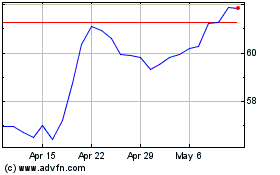By Ryan Tracy
WASHINGTON -- Should bank examiners work every day inside the
offices of banks they oversee, or not?
Two federal banking regulators have opposite answers, showing
how 10 years after the 2008 bailouts, regulators are still trying
to figure out the best way to stop bankers at Wells Fargo & Co.
and other firms from causing trouble.
The Federal Reserve Bank of New York recently finished moving
examiners -- who act like a tripwire to catch Wall Street misdeeds
-- to its headquarters on Maiden Lane in downtown Manhattan. They
previously worked inside big banks' offices, but the agency changed
course after criticism that examiners had grown too close to the
bankers they oversee, a phenomenon known as "regulatory
capture."
The Office of the Comptroller of the Currency, another big-bank
regulator, planned to move examiners in-house, too, before the
election of President Donald Trump. Now Mr. Trump's OCC chief,
former bank CEO Joseph Otting, wants examiners to remain ensconced
in banks' offices.
Bank examiners comb records and interrogate executives. If they
see a problem, they can order bankers to fix it and sanction banks
that don't listen. When examiners succeed at preventing
transgressions, hardly anyone notices. When they fail, consumers
suffer.
In 2010, OCC examiners working in Wells Fargo's San Francisco
headquarters, known as resident examiners, grew worried about the
firm's high-pressure sales culture. Eight products per customer was
the bank's goal, because "eight" rhymed with "great," its
then-chief executive said.
The examiners flagged their concerns in 2010: "We are aware of
no assessment of the risks and controls associated with the
corporate goal of cross selling eight products per household," they
wrote in an internal assessment.
Around six years later, the bank admitted to opening as many as
3.5 million fake accounts. An OCC ombudsman later said the resident
examiners didn't adequately follow up on their 2010 assessment or
subsequent warning signs of the fraud.
(The OCC did eventually force Wells Fargo to address the
problems and fined it $35 million in 2016.)
If those OCC examiners worked at the New York Fed today, they
would have desks at a regulatory office, instead of inside a
bank.
It's impossible to say whether changing examiners' working
location would have changed the outcome, but critics say "resident
examiner" programs breed complacency. Wells Fargo's sales-incentive
programs were more aggressive than those of industry peers. If the
OCC examiners had been comparing notes with colleagues assigned to
other banks, might they have pushed Wells Fargo earlier to clean up
its act?
If a bank examiner sees "the same thing day in and day out, you
get too trusting that that routine is OK. It's easy to get caught
in that," said Douglas Roeder, a managing director at PWC, a
consultancy, and a former OCC senior deputy comptroller in charge
of overseeing large banks.
A New York Fed spokeswoman said bringing supervisors back to
headquarters allows them to "more readily interact with colleagues
from other teams and compare and contrast firm practices, processes
and risks." She added that the regulator will retain some workspace
inside banks, where examiners can "continue to have regular and
consistent interactions" with bankers.
The Federal Reserve Bank of San Francisco, the Fed arm that
shares oversight of Wells Fargo, is also moving big-bank examiners
into regulatory offices, a spokesman said. Fed offices in most
other cities are taking the same approach.
Thomas Curry, who ran the OCC during the Obama administration,
wanted to cut down on resident examiners to "avoid the perception
of regulatory capture," he said in a 2017 interview before wrapping
up his five-year tenure.
Mr. Curry's team intended to move the examiners out of the
banks, but never did. Some OCC employees disagreed with the idea
because they didn't believe the OCC was "captured" by banks,
according to former officials. The change was also delayed due to
union negotiations and the cost of leasing new offices at a time
when the OCC was hiring many additional examiners, officials said.
Banks pick up the tab for office space for resident examiners.
Mr. Otting, the OCC's new leader, is sympathetic to a different
school of thought, which views the location of an examiner's desk
as a minor concern compared to other factors, such as training,
priorities and resources.
The OCC chief recalled that when he was CEO of OneWest Bank in
California, examiners worked on a separate floor, "kind of locked
down" away from bank staff. Mr. Otting valued the fact that if he
had a question for his examiner, or vice versa, "I could just go
down the elevator," he told reporters in December.
"In my mind the best solution would leave the regulators there,"
inside banks, he said, while ensuring that examiners don't work at
one bank for too long and that they regularly talk with examiners
at other banks. In addition, both the OCC and the Fed have beefed
up the number of staff tasked with comparing practices at different
banks and established Washington-based committees to review
examiners' major decisions.
At a big bank, examiners are outgunned no matter where they sit.
Wells Fargo has more than 260,000 employees. Overseeing them on any
given day are about 50 OCC examiners and examiners from other
regulators.
During the years when Wells Fargo's employees were opening phony
accounts, OCC examiners were auditing foreclosure practices across
a huge volume of mortgages, according to a person familiar with the
matter.
Write to Ryan Tracy at ryan.tracy@wsj.com
(END) Dow Jones Newswires
March 25, 2018 08:14 ET (12:14 GMT)
Copyright (c) 2018 Dow Jones & Company, Inc.
Wells Fargo (NYSE:WFC)
Historical Stock Chart
From Aug 2024 to Sep 2024

Wells Fargo (NYSE:WFC)
Historical Stock Chart
From Sep 2023 to Sep 2024
